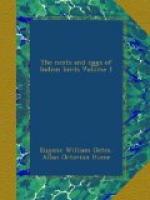As a rule these birds do not build in society, but at times, especially in Lower Bengal, I have seen a dozen of their nests on a single tree.
The nest is usually a shapeless mass of rubbish loosely put together, rough and ragged.
A note I recorded on one taken at Bareilly will illustrate sufficiently the kind of thing:—
“At the extremity of one of the branches of these same mango-trees, a small truss of hay, as it seemed, at once caught every eye. This was one of the huge nests of the Pied Pastor, and proved to be some 2 feet in length and 18 inches in diameter, composed chiefly of dry grass, but with a few twigs, many feathers, and a strip or two of rags intermingled in the mass. The materials were loosely put together, and the nest was placed high up in a fork near the extremity of a branch. In the centre was a well-like cavity some 9 inches deep by 31/2 inches in diameter, at the bottom of which, amongst many feathers, lay four fresh eggs.”
Five is the full complement of eggs, but they very often lay only four, and once in a hundred times six are met with.
From Hansie Mr. W. Blewitt writes that he “found numerous nests during May and June. They were all placed all keekur-trees, at heights of from 10 to 15 feet from the ground, the trees for the most part being situated on the banks of a canal or in the Dhana Beerh, a sort of jungle preserve.
“The nests were densely built of keekur and zizyphus twigs, and thickly lined with rags, leaves, and straw. Five was the greatest number of eggs that I found in any one nest.”
Writing of his experience in the Delhi and Jhansi Divisions, Mr. F.R. Blewitt remarks that “the Pied Pastor breeds from June to August, making its nests between the outer branchlets of the larger lateral branches of trees, without special choice for any one kind. The nest is altogether roughly made, though some ingenuity is evinced in putting all the material of which it is composed together. Twigs, grasses, rags, feathers, &c. are all brought into requisition to form the large-made structure, which I have found, though less commonly, at a higher altitude from the ground than the 8 or 10 feet Jerdon speaks of.”
Major C.T. Bingham writes:—“Breeds in Allahabad in June, July, and August; and at Delhi in May, June, and July. The nest is a large shapeless mass of straw, feathers, and rags, having a deep cavity for the eggs, which are generally five in number. The nest is almost always placed at the extreme tip of some slender branch, and there is no attempt at concealment.”
Mr. J.E. Cripps tells us that at Furreedpore, in Bengal, this Myna is “very common, and a permanent resident. They eat fruit as well as insects. Lay in May and June, building their huge nests at various heights from the ground, and in any tree that comes in handy. I have generally found the nests lined with the white feathers of the paddy-birds; some of the feathers being as much as six and seven inches in length. The nests were composed principally of doob-grass; three to four eggs in each nest.”




